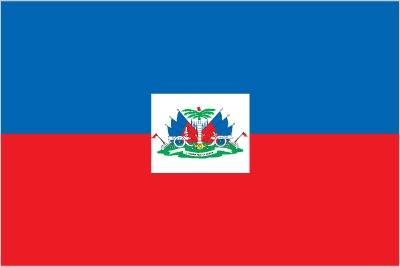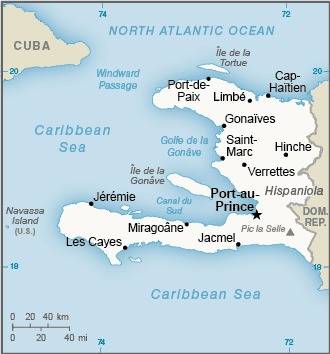22 Haiti

Two equal horizontal bands of blue (top) and red with a centered white rectangle bearing the coat of arms, which contains a palm tree flanked by flags and two cannons above a scroll bearing the motto L’UNION FAIT LA FORCE (Union Makes Strength). The colors are taken from the French Tricolor and represent the union of blacks and mulattoes.
Flag courtesy of the CIA World Factbook

Map courtesy of CIA World Factbook

Ile-à-Vache (Cow Island) is an island commune in the Les Cayes (Baie de Cayes) about 10 km (6 mi) off the coast of Haiti’s southwest peninsula. The island is about 13 km (8 mi) long and 3.2 km (2 mi) wide, with an area of 52 sq km (20 sq mi). The western end of the island has rolling hills and swamps; the eastern side of the island has a lagoon with a large mangrove forests. The island is surrounded by several dangerous shoals, reefs, and rocks that have been the cause of shipwrecks throughout history. The government has plans to develop this area’s tourism in a sustainable manner.
Photo courtesy of the CIA World Factbook
Government
According to Britannica, Haiti instituted universal suffrage in 1950, but most of its elections have been marred by ballot tampering. Its constitution was approved by referendum in 1987 but not actually put into effect until 1995, during Jean-Bertrand Aristide’s presidency. Further amendments were approved by the parliament in 2011 and took effect the following year. The constitution, which incorporates features of the U.S. and French constitutions, provides for a president who is both head of state and the country’s main power holder. The president is directly elected to a five-year term and may stand for reelection to a second, nonconsecutive term. The head of government is the prime minister, appointed by the president from among the parliamentary members of the majority political party. The bicameral parliament consists of a Senate and a Chamber of Deputies. Senators are elected for six-year terms and deputies for four.
The administration of local governance is carried out in three main divisions. The largest of these are départements, which are divided into arrondissements and, further, into communes. The effectiveness of an arrondissement’s administration varies considerably with its location; the closer it is to the département capital and the more urban it is, the more likely it is to function effectively as an administrative entity. If the administrative centre of the arrondissement is located in the same town as the capital of the département, then the administrative head of the arrondissement, the préfect, is likely to wield considerable influence and power. If the arrondissement is located in a rather inaccessible rural area, the village and hamlet elders are likely to have more power than any appointed government official. A commune and its officials, especially the commandant (a local authority similar to a town mayor), are usually the only government personnel with whom most Haitians have any contact.
The judiciary consists of four levels: the Court of Cassation (the highest court), courts of appeal, civil courts, and magistrate’s courts. Judges of the Court of Cassation are appointed by the president to 10-year terms. The Haitian legal system is nominally based on the Napoleonic Code, modified by legislation enacted during François Duvalier’s presidency (1957–71). The system is deeply flawed, and the government influences all levels of the court system, although the constitution calls for an independent judiciary. Prisoners can be held for months or years without a trial, sometimes despite court orders for their release, and many accused criminals have bought their freedom with bribes. A 2012 amendment to the constitution called for the establishment of a constitutional court to settle disputes between the executive branch and the parliament.
National Office of Civil Aviation (OFNAC)
In Haiti, the National Office of Civil Aviation (OFNAC), is the authority responsible for the implementation of international standards and recommendations and the execution of the policy of the Haitian State in the field of civil aviation. OFNAC is a key institution in the regulation and operation of the civil aviation system in the country. Their primary mission is to achieve safe, orderly and efficient civil aviation in the service of the socio-economic development of Haiti.
Airspace
SkyVector – Google Maps – ADS-B Exchange
ICAO countries publish an Aeronautical Information Publication (AIP). This document is divided into three parts: General (GEN), En Route (ENR) and Aerodromes (AD). ENR 1.4 details the types of airspace classes they chose to adopt from classes A through G.
Drone Regulations
Aerial Work – Part 11 of the Civil Aviation Regulations of Haiti (RACH) stipulates the requirements relating to the operations of aerial work, including agricultural aviation, outdoor load transport by helicopter, towing of gliders and banners, television and film operations, excursion flights, observation of fish and traffic information. Although the requirements of Part 11 appear to address operations carried out in Haiti, aircraft registered in Haiti may sometimes engage in aerial work in the States neighbors. These operations being carried out outside the Haitian borders, it is necessary that the aircraft be operated and maintained in accordance with the standards of the International Civil Aviation Organization, stipulated in other parts of the Civil Aviation Regulations of Haiti (RACH).
Advanced Air Mobility (AAM) Regulations & Policies
None found by the author.
However, should you, the reader, happen to stumble across something to the contrary, please email the author at FISHE5CA@erau.edu and you may be mentioned in the ACKNOWLEDGEMENTS section of this book by way of thanks for contributing to this free eBook!
Advanced Air Mobility (AAM) News
None found by the author.
However, should you, the reader, happen to stumble across something to the contrary, please email the author at FISHE5CA@erau.edu and you may be mentioned in the ACKNOWLEDGEMENTS section of this book by way of thanks for contributing to this free eBook!
Short Essay Questions
Scenario-Based Question
You have been hired by a Drone Startup Company. Your boss has immediately assigned this job to you.
They need you to prepare a one-page memo detailing the legalities of using a drone to film a promotional tourism video at Cow Island, pictured above.
They need you to mention any national laws and local ordinances.
They specifically want to know what airspace (insert pictures) you will be operating in and whether or not you need an airspace authorization.
Does it matter whether or not you are a citizen of the country?
Lastly, there is a bonus for you if, as you scroll through this chapter, you find any typos or broken links!
Short Essay Questions
- What are the drone categories?
- How is registration addressed?
- How is remote ID addressed?
- What are the model aircraft rules?
- What are the commercial drone rules?
- Are there waivers or exemptions to the rules? If so, for what?
- Would you share a link to an interactive airspace map?
- How is BVLOS addressed?
- How can you fly drones at night?
- How can you fly drones over people?
- Where do you find drone NOTAMs?
- What are the rules for drone maintenance?
- What are the rules for an SMS program?
- What are some unique rules not mentioned above?
- What are the C-UAS rules?
- What are the AAM rules?

